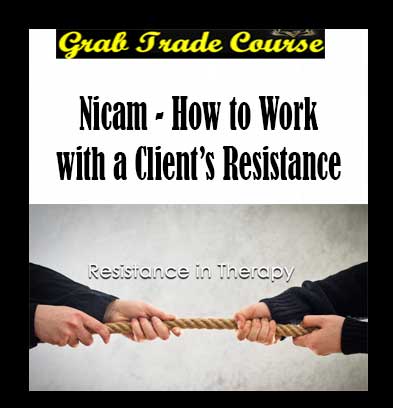Nicam – How to Work with a Client’s Resistance
Description
When our clients are distrustful or skeptical of our work, it can create difficult barriers to healing. To us, this can sometimes feel like resistance.
But is resistance even a valid notion?
- What may at first seem like opposition, can often signal our client’s deepest struggles.
- The difficult part is seeing beyond the “push back” to take in the important message our client is telling us, so we can work with instead of against their energy.
- So we asked the top 20 experts in our field how they worked with their most challenging clients. We were surprised by the deep dive of their answers.
- They gave us useful skills that can radically shift this kind of resistance and actually help reverse a client’s ambivalence to change.
- That’s why we made. . .
Nicam – How to Work with a Client’s Resistance
Part 1: How to Work with Reluctance Linked to Attachment Issues
- How a client’s movement vocabulary can reveal an inner conflict
- One way to help clients reestablish a sense of identity in their body
- How to approach implicit memories that fuel a client’s avoidance
Part 2: How to Resolve the Core Threat That’s Fostering Your Client’s Opposition
- How to change a combative session into a collaborative one
- How to isolate the main threat that’s feeding a client’s rigidity
- The simple but powerful way validation impacts an avoidant mindset
One Hidden Fear That May Be Driving Your Client’s Reluctance
- The counterintuitive reason your client may be avoiding change
- The unique way guilt affects a client’s feelings of unwillingness
How to Help Clients Move Out of a Defensive State
- The critical reason some clients fear calmness
- One physiological change that can alter how we interact with others
- The specific breathing pattern that can trap a client in a defensive state
3 Skills to Expand a Client’s Openness to Change
- One personality type that is most prone to challenging the therapy
- A 3-step action plan to foster change without triggering opposition
- How to promote a healthier mindset that resists barriers to growth
How to Work with the Deep Vulnerabilities That Keep a Client from Change
- The crucial message that can soften a client’s protective parts
- The specific way to introduce hope in the healing process (so it’s actually received)
- How to work with “rational deformity” to help clients build authentic connections
- The silent vulnerability that’s most often behind a client’s reluctance
How to Avoid Misdiagnosing Clients as Unmotivated
- The key factor that falsely presents as a lack of motivation
- The vital message your client is giving you when they don’t follow your advice
- The important difference between resistance and rigidity
- How a client’s specific cognitive style can keep them stuck in avoidance
How to Sell Behavior Change to Your Most Challenging Clients
- What can go wrong when you engage a client’s willfulness
- How to help clients be more open to your interventions
- What a client needs to get from you before they’ll agree to your ideas
How to Help Clients Shift from Reluctance to Openness
- How to identify seeds of unwillingness inside the therapeutic alliance
- One change that can improve your outcome with clients who oppose all your ideas
- How to work with clients who struggle to disclose feelings
- 3 therapeutic messages to help clients reverse their reluctance
How the Practitioner May Be Perpetuating Opposition in Their Client
- What can go wrong when you resist a client’s resistance
- How to recognize the dangerous way a client’s willfulness may be affecting you
- How to foster a high level of support for clients who don’t do the work
Course Director
Ruth Buczynski, PhD
Get 5 Bonuses That Give You Even More Strategies for Working with a Client’s resistance
The Brain Science Behind a Client’s Unwillingness (and How It Can Foster More Powerful Interventions)
- How “spiritual bypass” can keep clients stuck in avoidance (and how to work with it)
- Why underdevelopment of this part of the brain can lead to reluctance
How to Work with Avoidant Relationships
- Why it’s vital for you to introduce pain and discomfort in your work with certain couples
- How to help couples confront the vital issues they’ve learned to avoid
The Key Message Inside Your Client’s Unwillingness
- Why you should always walk toward your client’s resistance
- One professional risk that can strengthen the therapeutic relationship and foster change
One Change That Can Unravel a Client’s Rigid Beliefs
- The clarifying reason we need pushback from our clients
- Why you need to feel uncomfortable in your session (this can make all the difference)
- What lies beneath most clients’ rigid beliefs
How to Engage with a Willful Client
- The parenting model that can improve your work with willful clients
- The trick to working with willfulness (it may go against your natural inclination)
- The danger of using contingency management to foster behavior change









Reviews
There are no reviews yet.